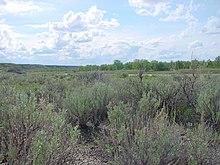Artemisia cana

| Artemisia cana | |
|---|---|
 | |
| Silver sagebrush in Dinosaur Provincial Park, Alberta | |
| Scientific classification | |
| Kingdom: | Plantae |
| Clade: | Tracheophytes |
| Clade: | Angiosperms |
| Clade: | Eudicots |
| Clade: | Asterids |
| Order: | Asterales |
| Family: | Asteraceae |
| Genus: | Artemisia |
| Species: | A. cana |
| Binomial name | |
| Artemisia cana | |
| Synonyms[2] | |
| |
Artemisia cana is a species of sagebrush native to western and central North America; it is a member of the sunflower family.[3][4] It is known by many common names, including silver sagebrush, sticky sagebrush, silver wormwood, hoary sagebrush, and dwarf sagebrush.[3][5][6]

Distribution
[edit]Artemisia cana, Silver sagebrush, is an aromatic shrub found in grasslands, floodplains and montane forests.[7] Artemisia cana is native to the Canadian provinces of British Columbia, Alberta, Saskatchewan and Manitoba and the American states of Alaska, Oregon, California, Idaho, Nevada, Utah, Arizona, Montana, Wyoming, Colorado, New Mexico, North and South Dakota, Nebraska and Minnesota.[6][4][8]
Description
[edit]The type specimen of Artemisia cana was described informally by its collector, Meriwether Lewis (collected on October 1, 1804, in the vicinity of Centinel Creek in South Dakota, during the epic Lewis and Clark Expedition), in the following passage from Original Journals of Lewis and Clark, edited by Thwaites in 1904 :
On these hills many aromatic herbs are seen; resembling in taste, smel [ [ [sic]] ] and appearance, the sage, hysop, wormwood, southernwood and two other herbs which are strangers to me the one resembling the camphor in taste and smell, rising to the height of 2 or 3 feet; the other about the same size, has a long narrow, smo[o]th, soft leaf of an agreeable smel [ sic ] and flavor; of this last the A[n]telope is very fond; they feed on it, and perfume the hair of their foreheads and necks with it by rubing [ sic ] against it.[9]
Artemisia cana generally reaches 50–150 centimetres (20–59 in) in height, with examples west of the Continental Divide typically being shorter than those east of the divide.[3]
The leaves have a narrow blade shape, are evergreen, grey-green in colour, and have a distinct aroma.[3]
Subspecies
[edit]- Artemisia cana ssp. bolanderi — Bolander's silver sagebrush, silver sagebrush — mountain meadows and streambanks in eastern California and Oregon, and northwestern Nevada.[10][11][12]
- Artemisia cana subsp. cana — plains silver sagebrush, Coaltown sagebrush, silver sagebrush — most of species range.[13]
- Artemisia cana ssp. viscidula — mountain silver sagebrush, Coaltown sagebrush, silver sagebrush — sagebrush lowlands in Great Basin, Colorado Plateau, Snake River Plain.[14]
References
[edit]- ^ Artemisia cana was first described and published in Flora Americae Septentrionalis; or, a Systematic Arrangement and Description of the Plants of North America 2: 521. 1813 "Plant Name Details for Artemisia cana". IPNI. Retrieved August 15, 2011.
- ^ a b The Plant List Artemisia cana Pursh
- ^ a b c d e "Artemisia cana in Flora of North America @ efloras.org". Retrieved 2014-01-10.
- ^ a b c "USDA Plants Profile: Artemisia cana". Retrieved 2014-01-10.
- ^ CalFlora taxon report, University of California: Artemisia cana, silver sagebrush
- ^ a b GRIN−National Plant Germplasm System: Artemisia cana
- ^ "NPIN: Artemisia cana (silver sagebrush)". Retrieved 2010-08-16.
- ^ Biota of North America Program 2014 county distribution map
- ^ William Clark. Original Journals of Lewis and Clark,1804–6. Vol. 1, Part 2. p. 307. Retrieved August 15, 2011.
- ^ Calflora: Artemisia cana ssp. bolanderi
- ^ Jepson Manual eFlora: Artemisia cana ssp. bolanderi
- ^ USDA Plants: Artemisia cana ssp. bolanderi
- ^ USDA Plants: Artemisia cana ssp. cana
- ^ USDA Plants: Artemisia cana ssp. viscidula

External links
[edit]- Calflora Database: Artemisia cana (Silver sagebrush)
- USDA Fire Sciences Laboratory: Artemisia cana
- Jepson Manual eFlora (TJM2) treatment of Artemisia cana subsp. bolanderi
- Lady Bird Johnson Wildflower Center−NPIN: Artemisia cana
- Saving The Sagebrush Sea
Artemisia cana.
